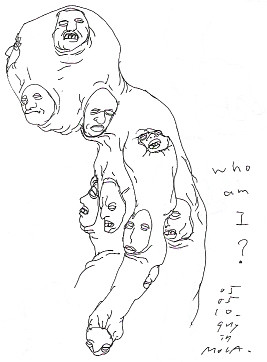Go for it!
首先要抱怨一下馬得逼,firefox居然當掉還我整篇得重打,開個Menupages.com也會掛點?吼啊!
今天終於跟David Nolen小meet一下,遲來的兩個月meeting(總是在臨時飽佛腳嘛哈哈吼)!We talked about some projects, including his thesis project "Human Paper Interface" which was a sort of software to generate an animation from a piece of paper drawed frame-by-frame character's motions. The software can automatically pull out all shapes by finding their borders instead of traditional way of manually adjusting all character's postures paper by paper. Of course you can do that in Photoshop, but, we both agree that there is a means by which human can easily talk to computer by simply drawing. Ya, we are both drawing maniac. I also showed my ICM projects to David and he was especially interested in my ICM midterm project "Cyou." (BTW, I dont really like this name. It's supposed to be CartoonYou, CarYou something else anyway.) I said, all my projects were persuing a new way to experience comics, which is perhapes so called interactive comics. Anyway, the conclusion is, I should totally work on something I will continue on even after graduate. That's how he treated toward his thesis. I might re-think all my projects and get more ideas about the possiblilty of going any further. Think about the scenario, give the prject a story behind the scene and make it somehting much more than just an excitement, a typical ITP project!
今天終於跟David Nolen小meet一下,遲來的兩個月meeting(總是在臨時飽佛腳嘛哈哈吼)!We talked about some projects, including his thesis project "Human Paper Interface" which was a sort of software to generate an animation from a piece of paper drawed frame-by-frame character's motions. The software can automatically pull out all shapes by finding their borders instead of traditional way of manually adjusting all character's postures paper by paper. Of course you can do that in Photoshop, but, we both agree that there is a means by which human can easily talk to computer by simply drawing. Ya, we are both drawing maniac. I also showed my ICM projects to David and he was especially interested in my ICM midterm project "Cyou." (BTW, I dont really like this name. It's supposed to be CartoonYou, CarYou something else anyway.) I said, all my projects were persuing a new way to experience comics, which is perhapes so called interactive comics. Anyway, the conclusion is, I should totally work on something I will continue on even after graduate. That's how he treated toward his thesis. I might re-think all my projects and get more ideas about the possiblilty of going any further. Think about the scenario, give the prject a story behind the scene and make it somehting much more than just an excitement, a typical ITP project!



